Title:Building GRPEACH as an IoT gateway
Displayed Name:Girishchandra Rajaram Yendargaye

| Concept / Overview |
|---|
| We take this opportunity to present this project documentation on “A Healthcare Support using Assisted Living Facilities System for Physically Challenged People: GR-PEACH as an IoT gateway” We would like to express our immense gratitude to the entire Renesas family for having provided all the essential support and encouragement. We would also like to thank all forums/help documents providers for support, encouragement and help provided for the entire duration of the project. Finally we would like to thank our colleagues who have helped us directly and indirectly for completion of our project. |
Project Overview
Today, our country is gearing up towards establishment of ‘Smart Cities’ that shall facilitate highly advanced overall infrastructure, sustainable real estate, and communications and market viability. It is a city where information technology is the principal infrastructure and the basis for providing essential services to residents.
One of the challenges that the healthcare sector has been facing in the last decade is how to ensure full coverage of Professional
Care for those who require special attention (e.g. the elderly, people with disabilities, or patients with chronic conditions), while the associated costs continue to increase.
An IoT gateway is a device that enables machine-to-machine Communication by connecting appliances in the home, workplace or smart city to cellular or Wi-Fi networks.
There are many incidents reported where,
- Nobody reach on time to support people at Home
- In Many Government Hospitals ignorance to these people has been observed mostly
Purpose
To address this challenge, Assisted Living Facility System (ALFS) allows an independent and safe lifestyle via the integration of information technologies/IoT with hospitals, homes and residences.
This system is mainly focused on addressing two problems:
Improving the quality of life for people in their own homes, especially the elderly, and supporting nurses and physicians in Hospitals to support caregivers which assist persons with disabilities Within Assisted Living Facilities System (ALFS)
Scope of System
We proposed the development and implementation of system which mainly works over WiFi, Ethernet & internet.
This further can be extended to cloud based system.
Tech. Used details & OS Environment
Mobile first is an approach to business process and technology that assumes Smartphone’s, tablets and task-specific apps are employees' primary tools for getting work done.
- This application is based on,
- Ethernet for GR Peach
- MQTT for exchanging data over Ethernet ,WiFi , internet
- WiFi for Node MCU
- Keeping mobile first approach in mind proposed system uses following technology.
- Below figure shows current Android OS users percentage for mobile first approach,
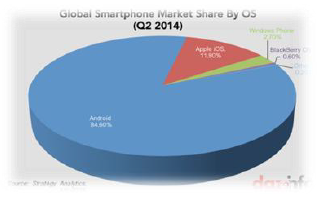
OS environment -Android Operating system API level 15 to 21
Existing Tools/API Used –Node Js MQTT Broker,
Programming Language -Java, C and MBED C
Hardware – GRPeach, Node MCU Relay Board, PIR Sensor

API – MQTT Client Library API provided by Android
User Interfaces – Android widgets like Linear Layout, Relative
Layout, and Scroll Layout with buttons have been used
Specifications
The specification to design and implement the healthcare support system presented in this project derive directly from
the guidelines reported below, with some additions. Table I below reports these specifications, numbered from 1 to 7.
They summarize the most important aspects followed to design and implement the system.
Table I
| Sl.No. | Requirement | Description |
| 1 | System Ubiquity | The system should support caregivers through their daily activities inside the assisted living facility System in Hospitals/Homes. |
| 2 | Smart Assistance | Thanks to the system, a patient/ an inhabitant should be able to instantly require the caregiver assistance. |
| 3 | Automatic Detection | The system should be able to detect potentially hazardous situations on based on some motion in which the patient/inhabitants may be involved without any explicit request. |
| 4 | Assistance Delivery Confirmation | The system should verify that for each request received from patient/inhabitants of the Hospital/Home, the proper assistance is actually provided. |
| 5 | Reliability and stbility | The system must be intrinsically safe, reliable, and stable, in particular for what concerns the communication between the devices. |
| 6 | Internet Availability | The system is an IoT solution and uses the Internet as a communication network. |
| 7 | Robustness of the devices | The used devices should be resistant to water and shocks. |
List of Components and Cost
| Sl.No. | Component Name | Description | Cost(Rs) |
| 1 | PIR Sensor | The PIR (Passive Infra-Red) Sensor is a pyroelectric device that detects motion by measuring changes in the infrared (heat) levels emitted by surrounding objects. | 150 |
| 2 | Relay Board | Actuator | 230 |
| 3 | Existing extension box Plug and Scockets | Extension Box | 400 |
| 4 | Node MCU | NodeMCU provide the best platform for IOT application development at the lowest cost ,Arduino-like hardware IO: Advanced API for hardware IO, which can dramatically reduce the redundant work for configuring and manipulating hardware. Code like arduino, but interactively in Lua script. , Nodejs style network API. | 490 |
| 5 | Jumper wires | Jumper wires male to male , male to female, female to female | 239 |
| 6 | Red and Green bulb and holders | Bulbs to show request and response status | 170 |
| 7 | LAN ethernet cable | LAN Cable | 109 |
Schematic Diagrams
i. Smart Extension Board
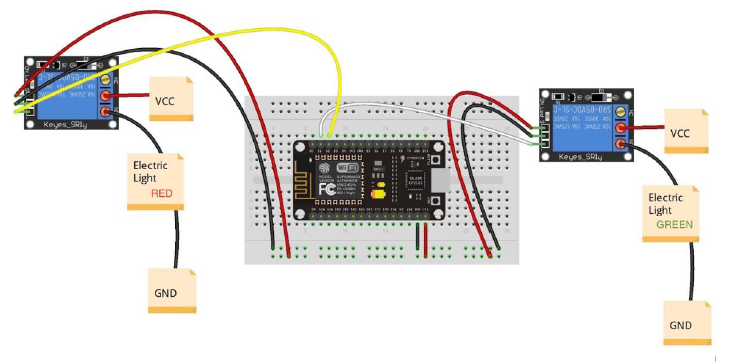
ii. Patients Device With GR Peach and PIR Sensor
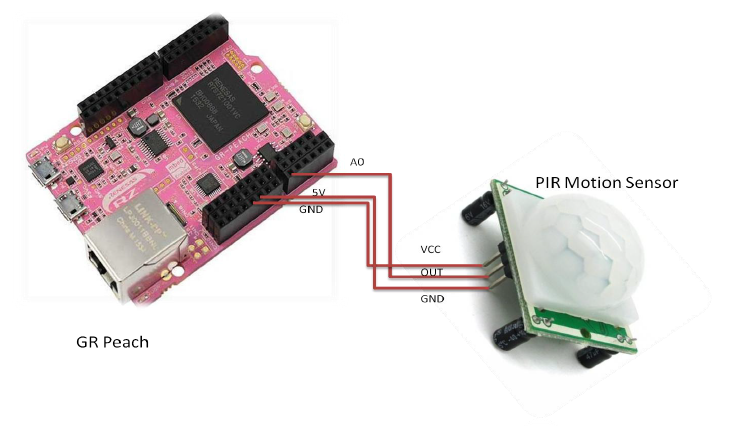
Basic Functionality of Project
i.Architecture
The architecture of the system is shown in Figure 1.
Each caregiver is equipped with an android mobile application
Patients are equipped with Motion detector Device.
With these devices the users can use the system regardless of their location inside the LAN Network if it’s not internet based System otherwise from anywhere.
Inhabitants are monitored through their motion in accessory provided.
Figure I
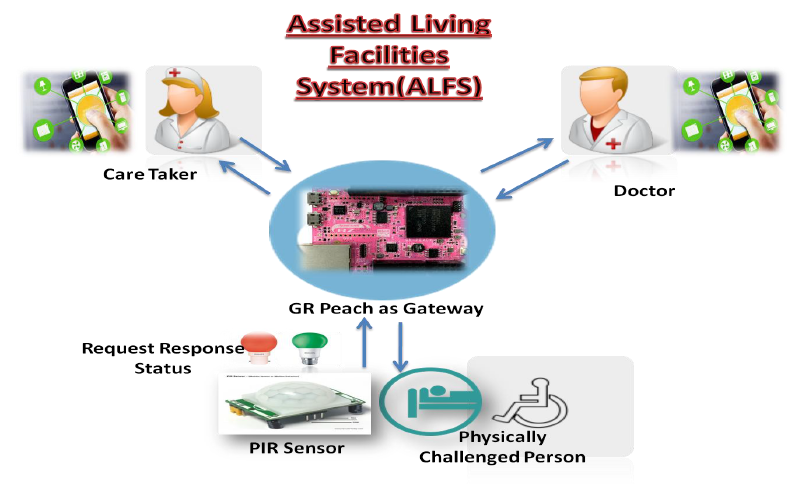
ii. System Design
The system can be divided into four main areas:
- Care givers mobile application
- Central NodeJS MQTT Broker
- Smart Status Board to Display request and response
- Patients device with PIR sensor and GR Peach
Care givers mobile application iAssist
We have developed MQTT based android application called iAssist in which Care giver has to provide IP address and port number of broker in settings in order to connect.
Care givers will have this android mobile application on which they will receive alert when patient request based on motion.
Care giveer can Acknowledge the same by publishing value and same can be shown as green light in patients room for 10 seconds.
This application also provides analysis of request taken and responses given at that time using Graphs.

Find figure 2 below which shows various operation which can be done using mobile app iAssist,
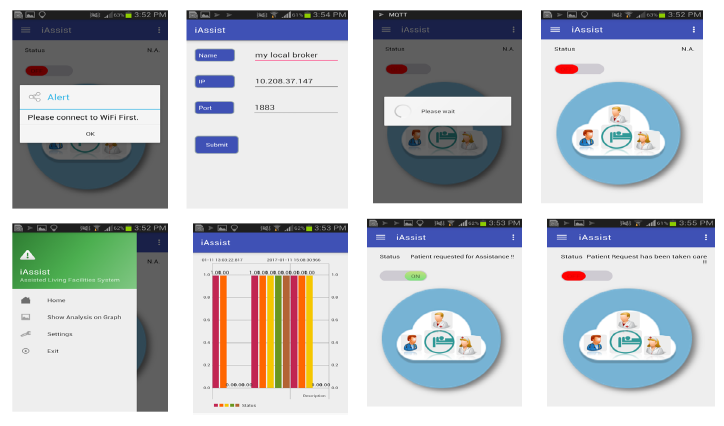
Central NodeJS MQTT Broker
This whole system works on MQTT Publisher and subscriber model,
MQTT was developed by Andy Stanford-Clark (IBM) and Arlen Nipper (Eurotech; now Cirrus Link) in 1999 for the monitoring of an oil pipeline through the desert. The goals were to have a protocol, which is bandwidth-efficient and uses little battery power, because the devices were connected via satellite link and this was extremely expensive at that time. The protocol uses a publish/subscribe architecture in contrast to HTTP with its request/response paradigm.Publish/Subscribe is event-driven and enables messages to be pushed to clients. The central communication point is the MQTT broker, it is in charge of dispatching all messages between the senders and the rightful receivers. Each client that publishes a message to the broker, includes a topic into the message. The topic is the routing information for the broker. Each client that wants to receive messages subscribes to a certain topic and the broker delivers all messages with the matching topic to the client. Therefore the clients don’t have to know each other, they only communicate over the topic. This architecture enables highly scalable solutions without dependencies between the data producers-Publishers and the data consumers-Subscribers .
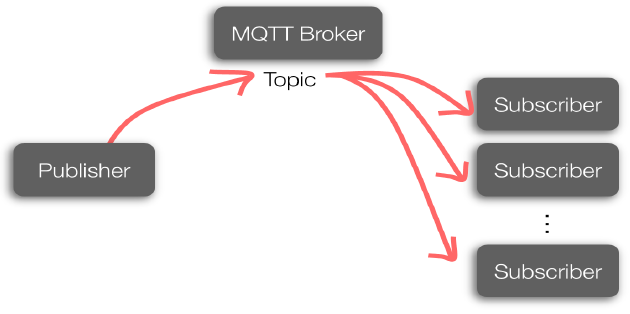
You have to start the broker by node server.js Command in order start the system.
Smart Status Board to Display Request and Response
Patients room has been provided with this smart board.Which we have made using existing extension box ,relay switch and node mcu.
This board gets connected to wifi named CDAC.
Whenever request i.e motion from PIR sensor is detected it turns on RED light in order to show that request has been put.
Similarly Care giver can send response on topic which will turn off RED light and glow GREEN light to show that care giver has received request will come soon to take care of patient.
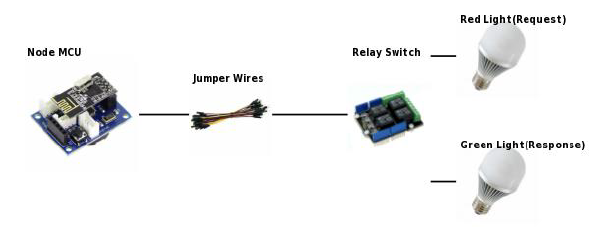
Patients device with PIR sensor and GR Peach
Patients room has been provided with this device.In Which we have PIR sensor connected to GR peach.
GR peach board should be connected to LAN/Internet
Whenever patient wants to put request he will simply do some motion in front PIR sensor device as result it turns on RED light on board in front in order to show that request has been put.
Similarly this device can be further extended using different kind of sensors.

Future Implementation Ideas
Along with handling limitations listed above this system can be further enhanced using below things
- This is jus PoC so registration of patient room and mapping at GR Peach is not yet done which can be enhanced
- Wearable devices can be implemented using more sensors
- Central server can be made to analyse data
- Rest services can be used for high level communication
- This system can be implemented in smart cities
References
- IEEE paper on Assisted Living Facilities
- https://developer.android.com/index.html
- Smart City Related News from Google
- Images from Google
- http://mqtt.org/
Finalist on GR-PEACH design contest in India 2016

